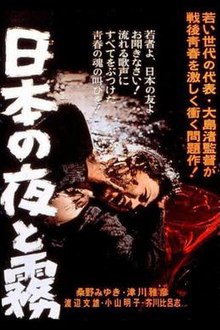Night and Fog in Japan
| Night and Fog in Japan | |
|---|---|
 |
|
| Directed by | Nagisa Oshima |
| Produced by | Tomio Ikeda |
| Written by | Nagisa Oshima Toshiro Ishido |
| Starring |
Fumio Watanabe Miyuki Kuwano Takao Yoshizawa |
| Music by | Riichiro Manabe |
| Cinematography | Takashi Kawamata |
| Edited by | Keiichi Uraoka |
|
Production
company |
|
|
Release date
|
|
|
Running time
|
107 minutes |
| Country | Japan |
| Language | Japanese |
Night and Fog in Japan (日本の夜と霧 Nihon no Yoru to Kiri?) is a 1960 Japanese film directed by Nagisa Oshima. It is an intensely political film both in subject matter (Zengakuren opposition in 1950 and 1960 to the AMPO Treaty) and in thematic concerns such as political memory and the interpersonal dynamics of social movements.
In 1960, uninvited guests interrupt the wedding ceremony between Nozawa, a journalist and former student radical of the 1950s, and Reiko, a current activist. They accuse the couple and assembled guests of forgetting their political commitments, invoking a tortured exploration of unresolved conflicts of a decade ago, when they were swept up in the student demonstrations against the AMPO treaty. In flashbacks, personal and political wounds are reopened, focused on Nozawa's subjective experiences in both 1950 and 1960. Two characters, one dead by suicide, the other now a Stalinist politician, are the subject of greatest scrutiny. The memory of Takao, a young student who committed suicide after letting a "spy" free, is reconstructed as a criticism of the authoritarian leadership of the Zengakuren of 1950. Nakagawa, former student leader now Communist functionary, is castigated for his role in the tragedy and his possession of Misako, a much desired female student. Other forgotten comrades from 1950 and fresh from the bloody demonstrations of 1960 are invoked as political and personal challenges. In the end, night and fog envelops the guests as they stand immobile to the stilted speech of the unchanged Nakagawa: memory has been invoked, but it is unclear whether or not anything has changed.
In 1948 the Zengakuren was formed, mobilizing Japanese students against the 1st AMPO treaty with the United States. This is the time period detailed in flashbacks, during which Nozawa, Nakayama, Misako, Takao, and Takumi were active. At the time, the Zengakuren was dominated by the Japanese Communist Party, represented in the film by the dogmatic leadership of Nakayama. Although resistance to the treaty failed in 1950, a new generation of student activists in 1960 challenged its renewal with massive street demonstrations, which once again ended in failure. This is Misako's generation, and the demonstrations covered by Nozawa. The Zengakuren of this period tried to assert its independence from the Japanese Communist Party, and subsequently fractured into several organizations that continued to retain the name. Night and Fog in Japan, with extensive political dialogue peppered with Marxist rhetoric, tries to make sense of political defeat and the reconciliation of these two generations. Although the marriage of Nozawa and Reiko seems to suggest the possibility of reconciliation, Nakayama looms large as the imposition of forced forgetting and the denial of reflection in favor of Party orthodoxy. Director Nagisa Oshima clearly was critical of Stalinism and the failure of political reflection. This pessimistic assessment pervades the film (Oshima had been involved in, and sympathized with, student movements himself), especially in the portrayal of personal motivations in political movements.
...
Wikipedia
